Any stage in software design, development, or maintenance should have a systematic approach to obtain a fully functioning product. To achieve this, a plan and strategy are essential to complete the work faster.
During the maintenance stage of software development, various testing processes are to be performed. So, the QA team needs a document with all details explained to execute the process.
To achieve this, we have the test plan and test strategy, the two main components and documents required before implementing the testing methods to the software. Let us look into the details of this article.
Table of content
- Test Plan: Definition
- Types of Test Plans
- Components of a Test Plan
- Steps to Write a Test Plan
- Importance of Test Plan
- Test strategy: Definition
- Types of Test Strategy
- Components of a Test Strategy
- Steps to Write a Test Strategy
- Importance of Test Strategy
Test Plan: Definition
Before executing any operation on the software, a set of rules or guidelines has to be followed. The QA team follows the plan framed already to carry out the testing process in the software. So what defines this set of rules and guidelines to execute the process? A test plan is constructed to make the work easier for the QA team.
A test plan is an instruction manual the QA team uses to perform the testing process on software or a website. The plan consists of all activities and instructions that need to be followed by the QA lead while performing a test in the software.
The structure of a test plan varies from organization to organization. It contains components such as test strategy, objectives, schedule, deliverables, and resources required to perform a test on the software.
The test plan is usually a document containing all the details of the software testing process. This description helps the team lead to easily execute the process and obtain the results faster.
Types of Test Plans
Based on the type of testing that is being performed and the level of testing, the test plan is divided into three types,
- Master test plan
- Test phase plan
- Specific test plans
1. Master Test Plan
The master test plan consists of high-level information related to the testing process. The information includes a procedure that needs to be followed at multiple levels of the testing process.
The master plan document includes codes, algorithms, execution procedures, outcomes, and the required resources at every step. Viewing the master plan document, the QA team can easily understand how to perform the test.
2. Test phase Plan
This type of plan document explains a particular part of the testing procedure. The document consists of details such as tools and strategies required during a single task of the entire testing process.
The test phase plan is a subset of the master plan and defines every process mentioned in the master test plan.
3. Specific test plans
Specific test plans can be subdivided into two types based on the type and level of the testing process,
- Testing Level Specific: This specifies the level of testing that needs to be carried out in various stages. For example, unit testing, integration testing, acceptance testing, etc. A specific level test plan elaborates when and how these tests should be conducted.
- Testing Type Specific: This is used to test certain parameters in the software, such as performance, security, load, etc. A specific type of test document helps determine how well the software functions.
Components of a Test Plan
Every test plan follows a general pattern or format which explains the work that needs to be done during the software testing process. The components and its description are as follows,
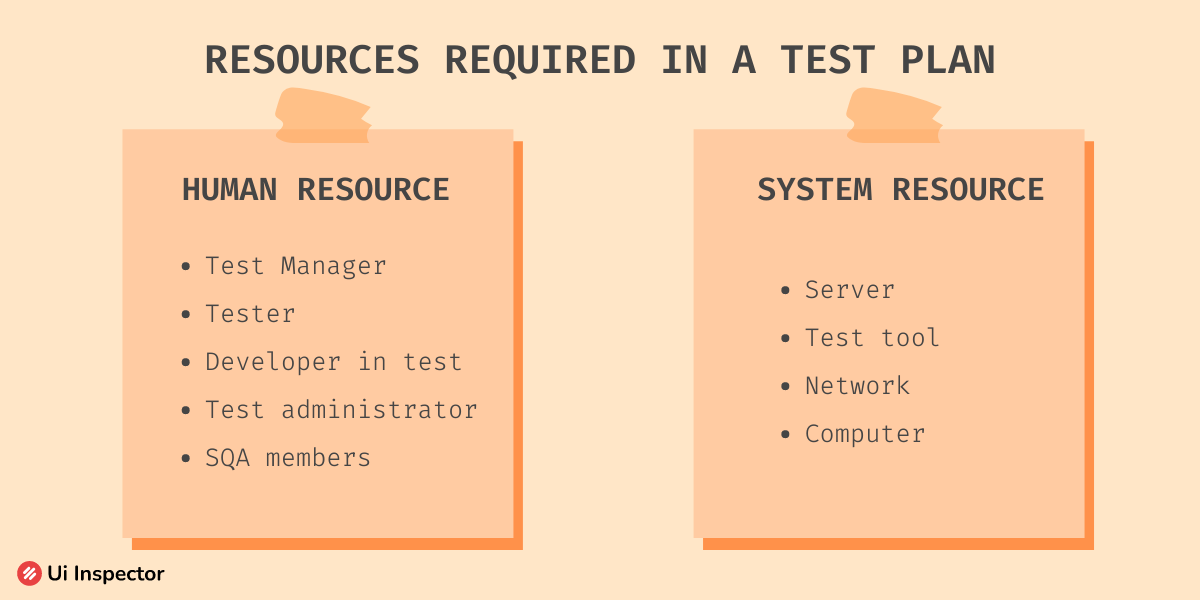
1. Test Plan Identifier
This unique identification number is provided for every test plan document. Test plan identifier helps to identify the project and contains information about the type of test.
2. Introduction
The introduction contains an overview of the entire plan, including the testing process's goals and objectives. In certain cases, the introduction also specifies the constraints present in the process.
3. References
This is a list of links and related documents regarding the project and configuration management plans.
4. Test Items
A list of tools and items that are required while conducting the software testing process.
5. Features to be tested
In this section, you will find a list of features that must be tested along with reasons for testing them. As an example, when analyzing the performance of software, it is also mentioned why it should be tested.
6. Features not to be tested
This includes a list of features that are not to be tested. The reasons for not testing them should also be listed along with the features.
7. Software risk issues
Potential risks and errors that might arise during the testing process are also listed priorly so that necessary arrangements can be made.
8. Approach
How the testing process will proceed is explained in the approach section. This contains the testing levels, types, and methods chosen for the software testing process.
9. Pass/Fail criteria
Based on what parameter the results are consolidated as pass or fail is mentioned in this section. According to this information, the test validates and gives us the results.
10. Suspension and resumption criteria
A test can suspend and resume at certain time intervals if any changes are needed. A criterion is therefore established for how and when a test should be suspended and resumed.
11. Test deliverables
This includes a list of deliverables that should be provided during and after the test is completed. The list contains,
- Test plan
- Test cases
- Test scripts
- Test data
- Defect reports
- Test reports
12. Test environment
When and where the test is performed is specified in this section. The test environment includes hardware, software, or network.
13. Estimate
This contains information about the cost and effort required to conduct and complete the test plan.
14. Schedule
Time schedules explain when and what should be accomplished during a particular time period. According to the schedule, the tests are conducted without any hindrances.
15. Staffing and training needs
The section also includes any requests for manual or staff support and the requirement for prior training sessions for the staff.
16. Responsibilities
The name of the role and the responsibilities taken care of by the staff are clearly mentioned under this category.
17. Assumptions and dependencies
The list of previously made assumptions and dependencies required for the test are listed here.
18. Approvals
Special approvals required to conduct the test from higher authorities, with their signature and date are obtained from the concerned person. The signatures of the staff in charge are also collected.
19. Glossary
This includes the alphabetical order of contents present inside the document.
Steps to Write a Test Plan
A test plan outlines how a software testing process should be executed. The plan document contains all information from the initial to the final steps. There is a defined structure for writing a test plan, including all the components mentioned earlier.
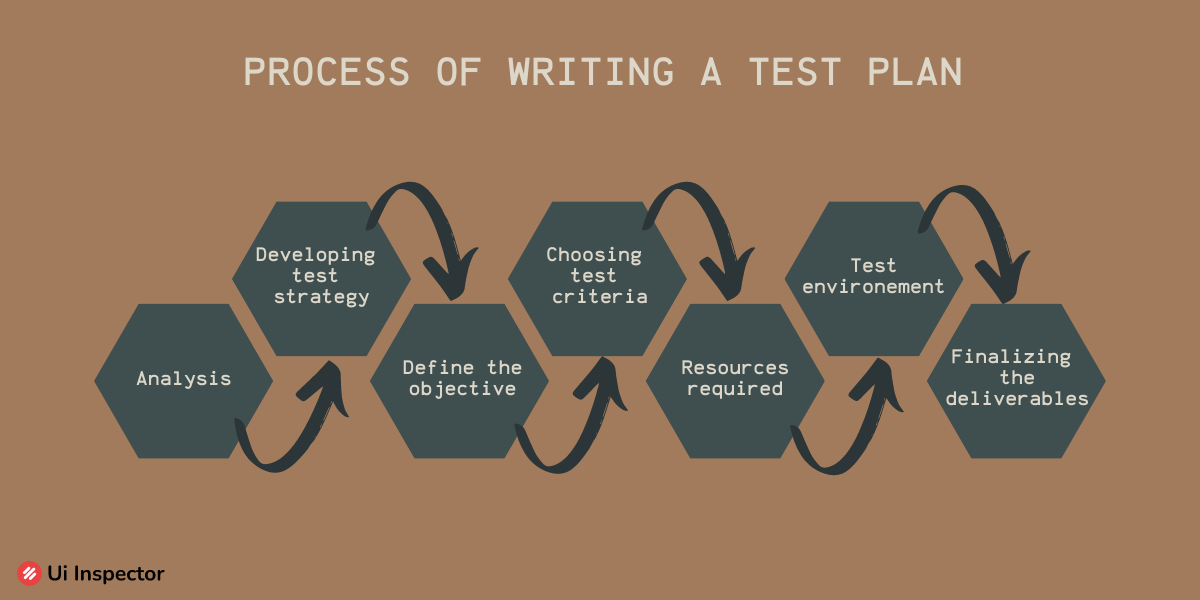
Analysis
Any product can be tested only if the QA team has complete knowledge of the software and its features. So before carrying out any testing process, a thorough analysis should be done about the software.
Various information about the software is collected during the analysis of the product. Only based on the collected information the testing plan is drafted. The analysis report consists of information like,
- Target audience
- Application of the software
- Purpose of using the software
- Functioning of the software
- Tools and features used
Developing test strategy
The important step in creating a test plan is to form a test strategy for the process. The test strategy consists of all details related to the test process, such as,
- Why is testing needed?
- Type of testing
- Risks and issues involved
- Tools required
Defining the objective
The test objective explains the need and purpose of the testing. This generally explains the overall goal of the test and also gives us the targetted results that need to be obtained from the test cases.
Apart from these, the test objective specifies the features that must be tested in the software. The features usually considered are performance, UI, usability, security, functionality, and hardware.
Choosing the test criteria
Every test will have a result that is usually predicted earlier. The judgment of the results is usually based on the test criteria, which are of two types,
- Suspension criteria: This allows the test cases to fail while running on the software.
- Exit criteria: This specifies the percentage of tests that get completed.
Resource required
While performing a test, the process requires various resources such as manpower, equipment, tools, employee, and materials. Before executing the test, an estimation of the resources required should be listed and the availability should be ensured.
Test environment
Now that the entire plan and progress of the test are framed, the QA team should decide where the test is to be performed. The test environment is also crucial in the process of software testing.
Depending on the type of testing and which feature is being tested, the testing region is identified in either software or hardware. When the test cases are executed in the wrong regions, then the purpose and objective of testing are not achieved.
Finalizing the deliverable
All essential deliverables and requirements are finalized. The entire detailed report is added to the test plan document for the QA team to plan accordingly and execute the test hassle-free.
Importance of Test Plan
- A test plan provides all the insights related to the test process to be executed in the software or hardware.
- All basic information about the test cases is clearly explained.
- The test plan makes it easier for the QA team to perform the test easily, and the process can be shared with other team members without confusion.
- Creating a test plan helps in enhancing communication between the employees.
- Since the outcome of the tests is predicted, the analysis of the functioning of the software can be done easily.
Test strategy: Definition
Test strategy can be considered as a component of the test plan, where the testers' team determines the overall outline and flow of the testing process. The process of creating is strategy is considered to be crucial since it determines the entire testing process.
The test strategy is created and finalized by the team manager. Viewing the test strategy will make it easier for the managers, developers, and QA team to understand the work according to the plan.
Apart from framing a workflow, the test strategy will also provide various solutions and answers to the software problem that might arise while functioning the website. Test strategy can also determine the level and method of testing to be implemented in the software.
Types of Test Strategy
Based on various factors such as testing level, method of testing, tools used, estimation, etc., a test strategy is divided into various types,
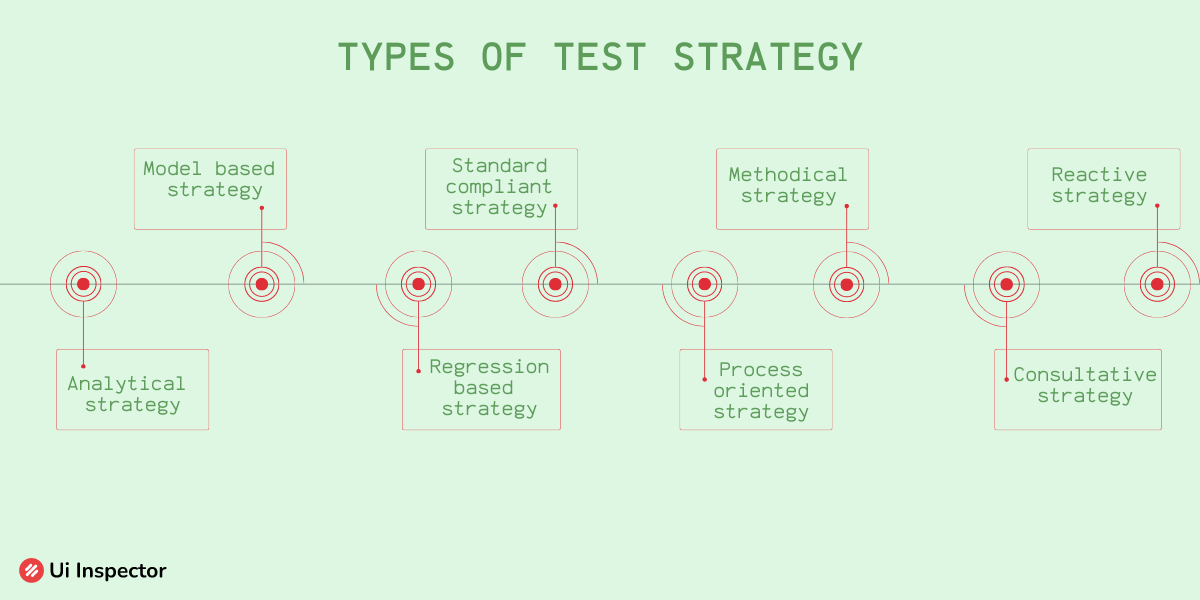
- Analytical strategy: This strategy is used to find and test the risks present in the software. The test is made to run, and the results are obtained based on whether the requirements have passed or failed.
- Model-based strategy: Based on the data obtained from the current and expected situation, a model is created with the input, output, processes, etc. On viewing the model, it will be easier to interpret the information that is given.
- Regression-based strategy: This test usually contains regression tests performed on the software. The test case is created in such a way that it decreases regression disks and functional and non-technical shares.
- Standards-compliant strategy: To perform this strategy, the test team usually needs to follow the standards and guidelines provided by the committee of experts such as HIPAA, FDA, etc.
- Methodical strategy: Methodical strategy consists of various features noted down as a checklist. According to the checklist and priority, the tests are being performed on the software.
- Process-oriented strategy: When the tests are conducted based on the existing IEEE standards, it is called a process-oriented strategy.
- Reactive strategy: This can be executed only when the full software is ready. The test strategy is defined for further testing based on the experiments and results obtained. This type is called reactive strategy.
- Consultative strategy: The strategy is framed accordingly based on the users' opinions and client requests. The requirements of the clients are taken into account in the consultative strategy.
Components of a Test Strategy
The framework of a test strategy consists of various components to easily interpret the workflow of the test process.
- Scope: This contains the product's overall view and highlights who should perform and review the testing process.
- Testing methodology: This specifies the levels of testing, testing procedure, roles, and responsibilities of the team members. The pattern of how the testing should proceed is also explained under the methodology.
- Testing environment: The regions where testing is to be done and the number of test environments are specified in this section.
- Testing tools: To perform a testing process requires various equipment and tools. Before starting the process, this section mentions a list of the tools needed.
- Release control: Release management is also a crucial step in the testing process. This is usually done for an effective test process.
- Risk analysis: During a test process, it is common to encounter various risks and defects in various regions. So the potential risks are listed priorly with their solutions under this section.
- Review and approval: The reviewing of test documents is done by the team leads of different departments. So a list of who should approve the document and when it should be done is also mentioned along with the test strategy.
Steps to Write a Test Strategy
Developing the test strategy defines how and who should perform the testing under the software testing. So, this is usually a crucial step, and more importance is given to creating the test strategy. The steps for creating a test strategy are as follows,
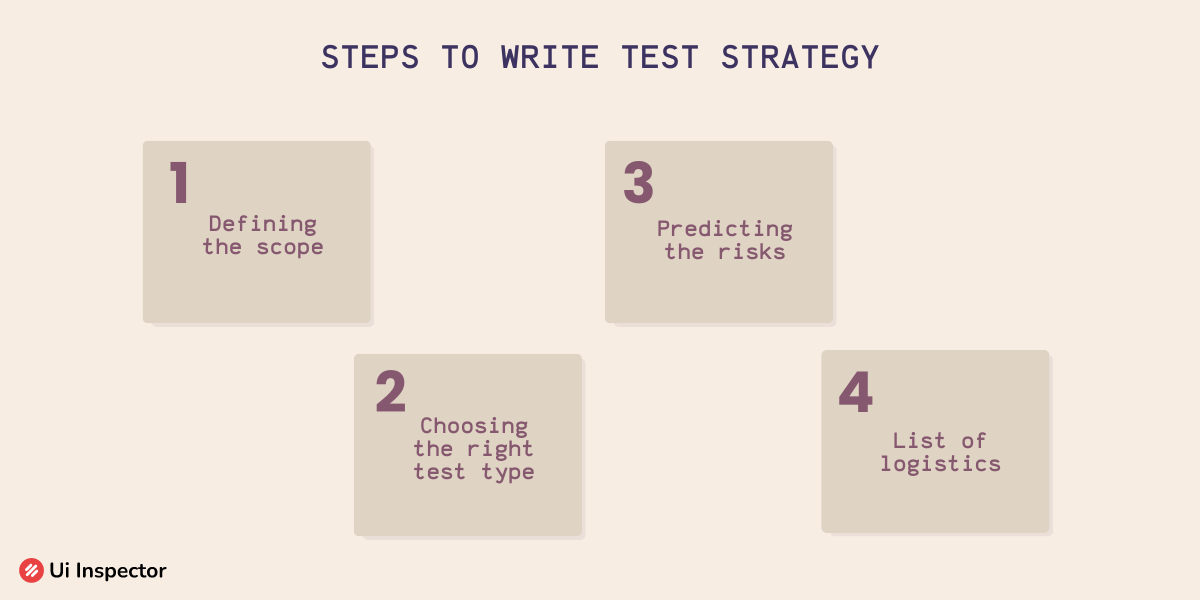
1. Defining the scope
The scope specifies the features and applications tested in the product, like software, hardware, or middleware. The features that are not to be tested should also be mentioned under the scope of the test.
Defining the scope is based on various parameters and the client's requirements. The parameters include,
- Client requirements
- The total budget of the product
- Specification of the product to be tested
- Special skills of the team
2. Choosing the right test type
Various test types are found under the software testing process based on what feature is being tested. Prioritizing the issue found according to the severity, the QA team chooses the test type to be implemented.
Some commonly used test type includes,
- Unit test
- Integration test
- Regression test
- Usability test
- Smoke test
3. Predicting the risks
The system's uncertain bugs or errors are not easily predictable. But based on the experience and knowledge of the test team, a few issues and risks that might arise in the software can be determined.
The solutions to mitigate these potential risks are also listed to easily resolve the problem.
4. List of logistics
The test logistics include,
- Tools required for testing
- Members who will carry out the test
Every step in the testing process may contain different requirements, so it is priorly listed in the strategy document to make necessary arrangements.
Importance of Test Strategy
The preparation of a test strategy document contains a lot of benefits for the test team, like,
- This helps identify the bugs faster because the process is defined earlier. The detection and rectification is easier.
- All the data and statistics of the test process are clearly mentioned. So the test team can easily find and predict the possible problems in the software.
- Frequent changes can be made easily, and the process can also be altered based on the changing requirements.
Conclusion
Test strategy and test plan are extremely important documents for the software testing process because they give the entire workflow of how every step should be done. A test plan is what gives the entire process, but a test strategy is just a part of the test plan document.
Making work easier is what every feature strives to do. These two documents make the testing process faster and quicker without any hindrances. The team can execute the test and obtain the results by looking at the document.
Seamless Testing with No-Code Platform
Ui Inspector is a no-code test automation platform that accelerates testing processes, increases test coverage, enables continuous testing, delivers reliable test execution, provides actionable insights, and optimizes costs and resources.
It supports comprehensive end-to-end tests that span multiple layers of an application, ensuring critical functionalities are thoroughly tested.
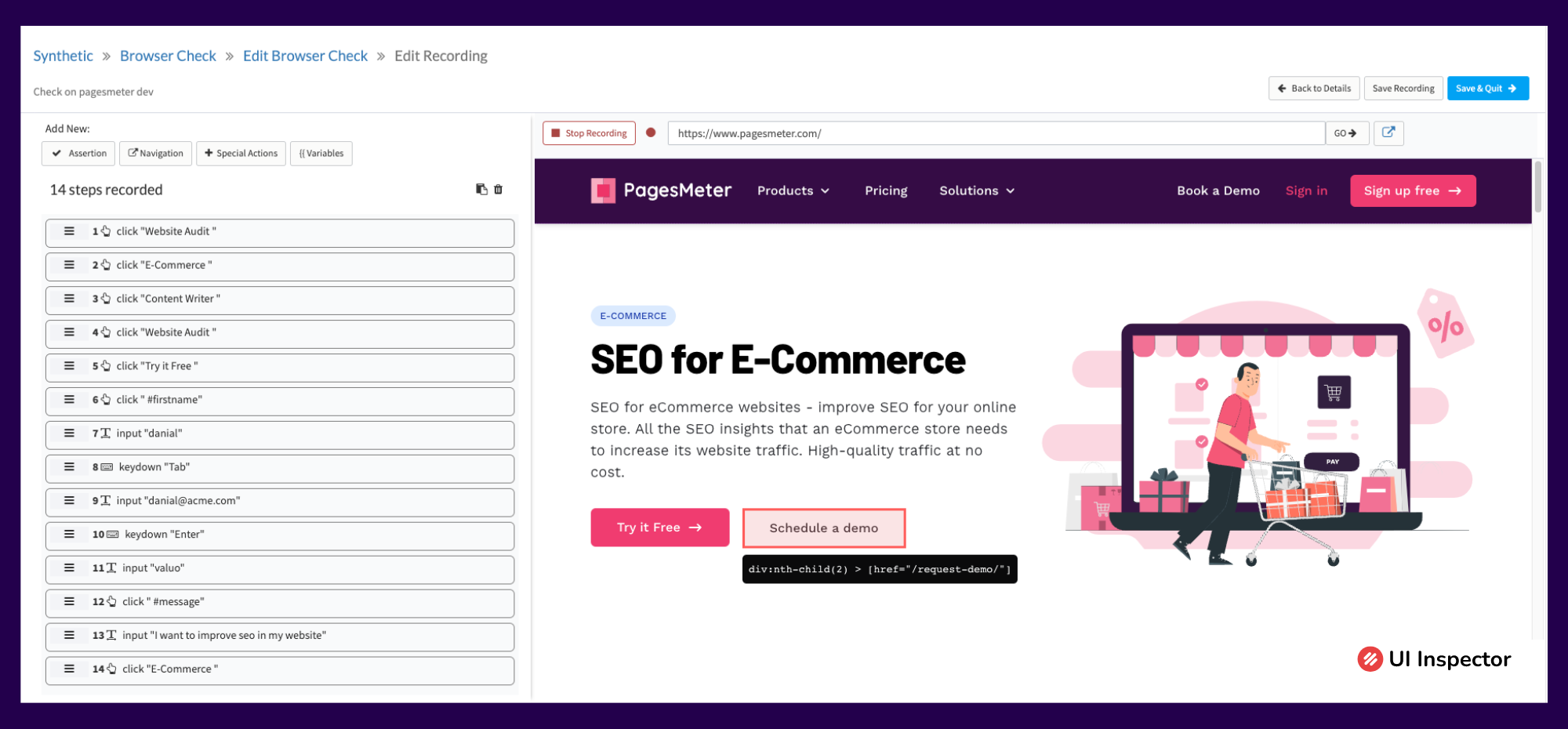
Its user-friendly interface allows non-technical users to create and run automated tests effortlessly. This empowers individuals from various roles to contribute to the testing process effectively.
With Ui Inspector's AI-powered test generation capabilities, test creation, and execution become faster, enabling teams to release high-quality software at an accelerated pace.
Sign up now for UI Inspector's 14-day free trial offer and experience the power of its features to discover limitless possibilities!


